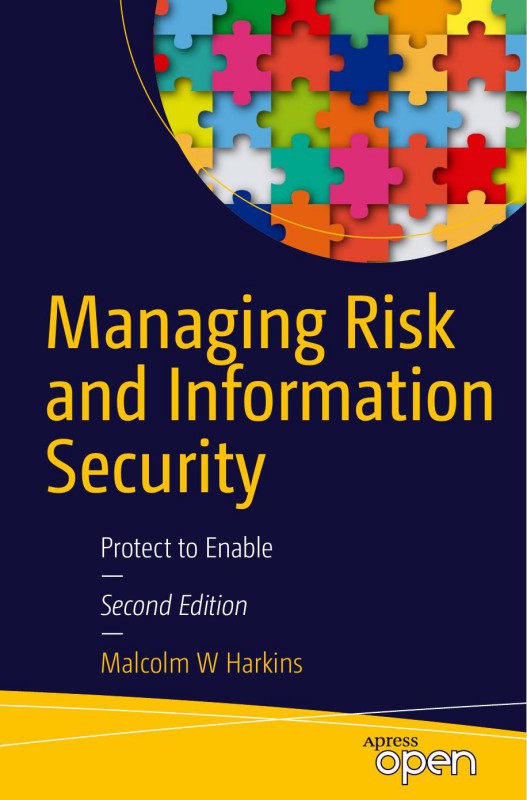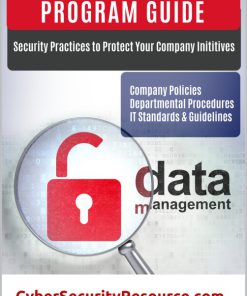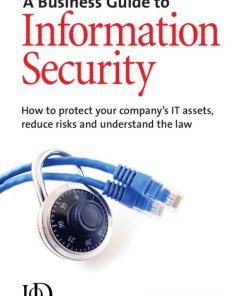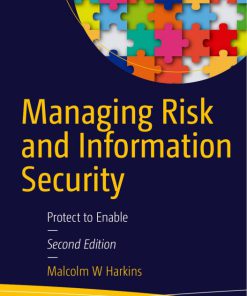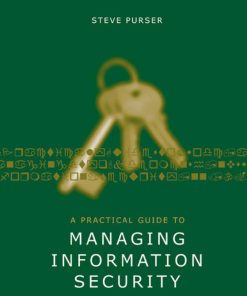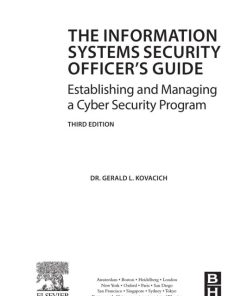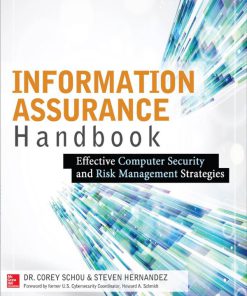Managing Risk and Information Security Protect to Enable 2nd edition by Malcolm Harkins ISBN 1484214560 978-1484214565
Original price was: $50.00.$25.00Current price is: $25.00.
Authors:Malcolm Harkins , Series:Cyber Security [276] , Tags:Computers; Security; General; Online Services; Information Technology; Networking; Language Arts & Disciplines; Library & Information Science , Author sort:Harkins, Malcolm , Ids:Google; 9781430251132 , Languages:Languages:eng , Published:Published:Dec 2012 , Publisher:Apress , Comments:Comments:Managing Risk and Information Security: Protect to Enable, an ApressOpen title, describes the changing risk environment and why a fresh approach to information security is needed. Because almost every aspect of an enterprise is now dependent on technology, the focus of IT security must shift from locking down assets to enabling the business while managing and surviving risk. This compact book discusses business risk from a broader perspective, including privacy and regulatory considerations. It describes the increasing number of threats and vulnerabilities, but also offers strategies for developing solutions. These include discussions of how enterprises can take advantage of new and emerging technologies—such as social media and the huge proliferation of Internet-enabled devices—while minimizing risk. With ApressOpen, content is freely available through multiple online distribution channels and electronic formats with the goal of disseminating professionally edited and technically reviewed content to the worldwide community. Here are some of the responses from reviewers of this exceptional work: “Managing Risk and Information Security is a perceptive, balanced, and often thought-provoking exploration of evolving information risk and security challenges within a business context. Harkins clearly connects the needed, but often-overlooked linkage and dialog between the business and technical worlds and offers actionable strategies. The book contains eye-opening security insights that are easily understood, even by the curious layman.†Fred Wettling, Bechtel Fellow, IS&T Ethics & Compliance Officer, Bechtel “As disruptive technology innovations and escalating cyber threats continue to create enormous information security challenges, Managing Risk and Information Security: Protect to Enable provides a much-needed perspective. This book compels information security professionals to think differently about concepts of risk management in order to be more effective. The specific and practical guidance offers a fast-track formula for developing information security strategies which are lock-step with business priorities.†Laura Robinson, Principal, Robinson Insight Chair, Security for Business Innovation Council (SBIC) Program Director, Executive Security Action Forum (ESAF) “The mandate of the information security function is being completely rewritten. Unfortunately most heads of security haven’t picked up on the change, impeding their companies’ agility and ability to innovate. This book makes the case for why security needs to change, and shows how to get started. It will be regarded as marking the turning point in information security for years to come.†Dr. Jeremy Bergsman, Practice Manager, CEB “The world we are responsible to protect is changing dramatically and at an accelerating pace. Technology is pervasive in virtually every aspect of our lives. Clouds, virtualization and mobile are redefining computing – and they are just the beginning of what is to come. Your security perimeter is defined by wherever your information and people happen to be. We are attacked by professional adversaries who are better funded than we will ever be. We in the information security profession must change as dramatically as the environment we protect. We need new skills and new strategies to do our jobs effectively. We literally need to change the way we think. Written by one of the best in the business, Managing Risk and Information Security challenges traditional security theory with clear examples of the need for change. It also provides expert advice on how to dramatically increase the success of your security strategy and methods – from dealing with the misperception of risk to how to become a Z-shaped CISO. Managing Risk and Information Security is the ultimate treatise on how to deliver effective security to the world we live in for the next 10 years. It is absolute must reading for anyone in our profession – and should be on the desk of every CISO in the world.†Dave Cullinane, CISSP CEO Security Starfish, LLC “In this overview, Malcolm Harkins delivers an insightful survey of the trends, threats, and tactics shaping information risk and security. From regulatory compliance to psychology to the changing threat context, this work provides a compelling introduction to an important topic and trains helpful attention on the effects of changing technology and management practices.†Dr. Mariano-Florentino Cuéllar Professor, Stanford Law School Co-Director, Stanford Center for International Security and Cooperation (CISAC), Stanford University “Malcolm Harkins gets it. In his new book Malcolm outlines the major forces changing the information security risk landscape from a big picture perspective, and then goes on to offer effective methods of managing that risk from a practitioner’s viewpoint. The combination makes this book unique and a must read for anyone interested in IT risk.” Dennis Devlin AVP, Information Security and Compliance, The George Washington University “Managing Risk and Information Security is the first-to-read, must-read book on information security for C-Suite executives. It is accessible, understandable and actionable. No sky-is-falling scare tactics, no techno-babble – just straight talk about a critically important subject. There is no better primer on the economics, ergonomics and psycho-behaviourals of security than this.†Thornton May, Futurist, Executive Director & Dean, IT Leadership Academy “Managing Risk and Information Security is a wake-up call for information security executives and a ray of light for business leaders. It equips organizations with the knowledge required to transform their security programs from a “culture of no†to one focused on agility, value and competitiveness. Unlike other publications, Malcolm provides clear and immediately applicable solutions to optimally balance the frequently opposing needs of risk reduction and business growth. This book should be required reading for anyone currently serving in, or seeking to achieve, the role of Chief Information Security Officer.†Jamil Farshchi, Senior Business Leader of Strategic Planning and Initiatives, VISA “For too many years, business and security – either real or imagined – were at odds. In Managing Risk and Information Security: Protect to Enable, you get what you expect – real life practical ways to break logjams, have security actually enable business, and marries security architecture and business architecture. Why this book? It’s written by a practitioner, and not just any practitioner, one of the leading minds in Security today.†John Stewart, Chief Security Officer, Cisco “This book is an invaluable guide to help security professionals address risk in new ways in this alarmingly fast changing environment. Packed with examples which makes it a pleasure to read, the book captures practical ways a forward thinking CISO can turn information security into a competitive advantage for their business. This book provides a new framework for managing risk in an entertaining and thought provoking way. This will change the way security professionals work with their business leaders, and help get products to market faster. The 6 irrefutable laws of information security should be on a stone plaque on the desk of every security professional.†Steven Proctor, VP, Audit & Risk Management, Flextronics




